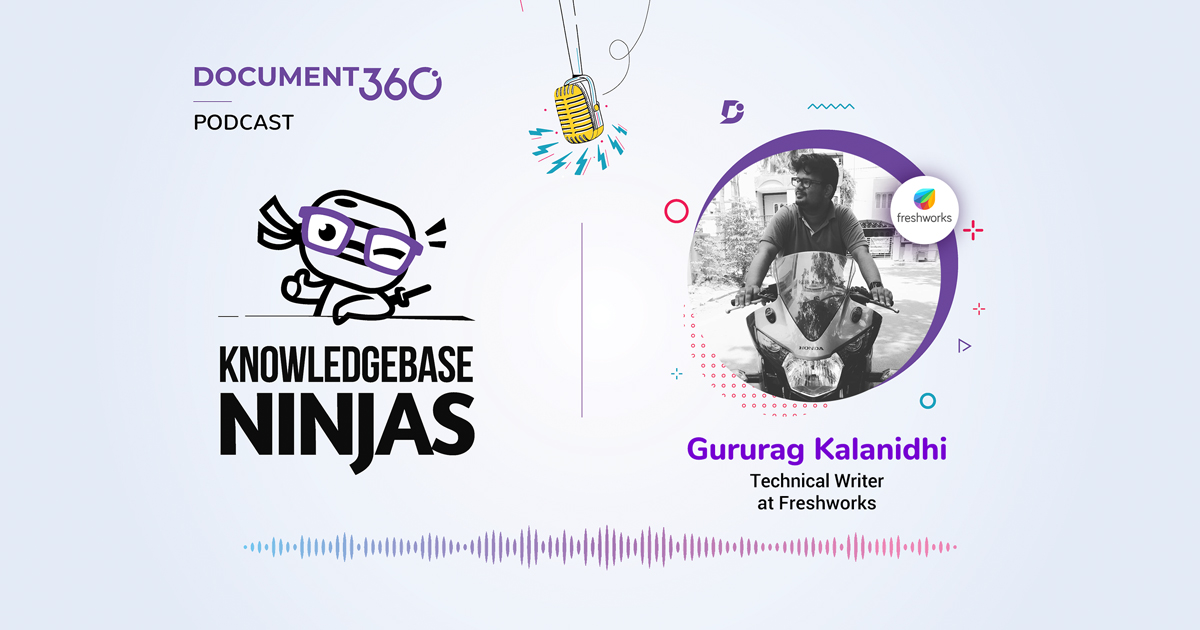Gururag Kalanidhi, Technical writer at Freshworks, joins us in this episode of Knowledgebase Ninjas to talk about the key factors in technical documentation. Check out all the other episodes of Knowledgebase Ninja here.
Connect with Gururag Kalanidhi and Freshworks at:
Key Takeaways
Gururag’s journey through content creation towards technical documentation
Gururag started his career four and a half years back, as a content writer. Given his challenging nature and a strong belief in DIY, he was very intrigued by the offer at Freshworks, where he would have to write customer phrasing content. Content that will be used by businesses to set up their product. That is when he started working at Freshworks, and he has been handling fresh sales CRM products for almost three years now.
The customers he deals with are across industry segments who do not have the luxury paying for the services of a consultant. Although his task was demanding, it fascinated him at the same time.
The Freshworks documentation process
Gururag explains how Freshworks follows an agile methodology in business. It is a collective task that is split into multiple modules and numerous stakeholders that work on an individual module. He says the process is a bit tough as they have to start from scratch because they do not have the exact amount of hand holding that they need to get started.
Gururag mentions that the role of technical writers usually involves working with developers and project managers to understand what a particular module is, and then define how it needs to look like, and lastly write the content itself for the knowledge-based article.
Role of formatting and presentation in documentation
To make the content as descriptive and ascriptive; assuring it is not jargon intensive and easy to set up for anyone using it is the role of formatting and presentation in creating a document, says Gururag.
He tells us that when it comes to formatting, they try to maintain a standard guide and make sure it is not technobabble, having their users feel the product is too technical and complicated to set up. Hence, they do not read through the entire content.
As far as presentation is concerned, they rely extensively on using screenshots and illustrations to help understand how a particular product is because generalizing them with UA is an essential aspect of their content. When we asked further elaborate, Gururag mentioned that backing your content with illustration is equally crucial. Making your content lively and straightforward with videos or screenshots is vital, so the customers don’t get lost. He tells us that this will keep them engaged in your content, and as they see the pictures they can try it out on the product there and then.
Other Important factors to consider when creating technical documentation
Our guest lays most emphasis on the element of empathy. Gururag elaborates that the content should be simple enough to be self-explanatory to a layman. The customer attitude is more plug-and-play device-driven. They want to start and to get going with it from day one. So making sure that the document is user-friendly and comprehensive is the key to it. Rather than putting in vague explanations, they prefer to keep it to the point and minimum information. If there are edge cases they need to cover, they try to cater to their customer’s case by case basis.
Dividing workload
Even though their team is relatively small, which is only two people in a team, they share the workload. It is more of a collective effort between the developers and project managers and technical writers.
Also, given that their documentation is public, they write their content in such a manner that it is keyword optimist, which attracts organic traffic. However, they have to introduce a lot of modules for the fast-moving products and focus on ensuring adequate documentation that is required by the customer, so they do not have to come back to our support team asking for further clarifications on setting up. It is also well in line with the market requirements.
What documentation related advice would Gururag give to his 20-year-old self?
Don’t write the content that is going to be for a story. Right content from a customer’s standpoint.” Says Gururag. He adds on by saying, you should aim to value your customer’s time, rather than waste it with making it too flowery and writing unwanted details.
Who has inspired Gururag in his technical writing career?
- His sales team & colleagues
Gururag’s Favourite Documentation Related Resource:
Subscribe to Knowledgebase Ninjas
Quote:





 –
– 

